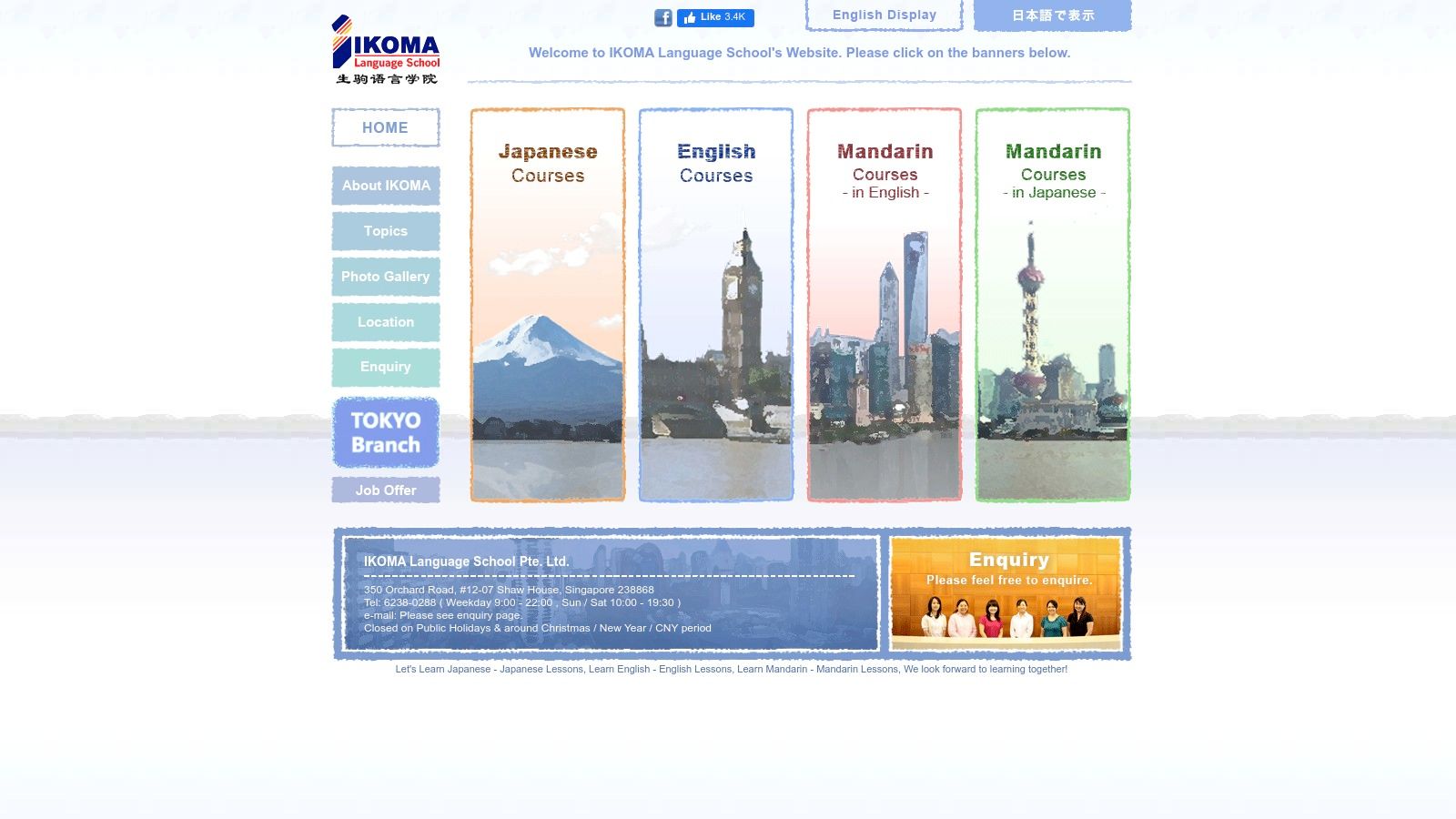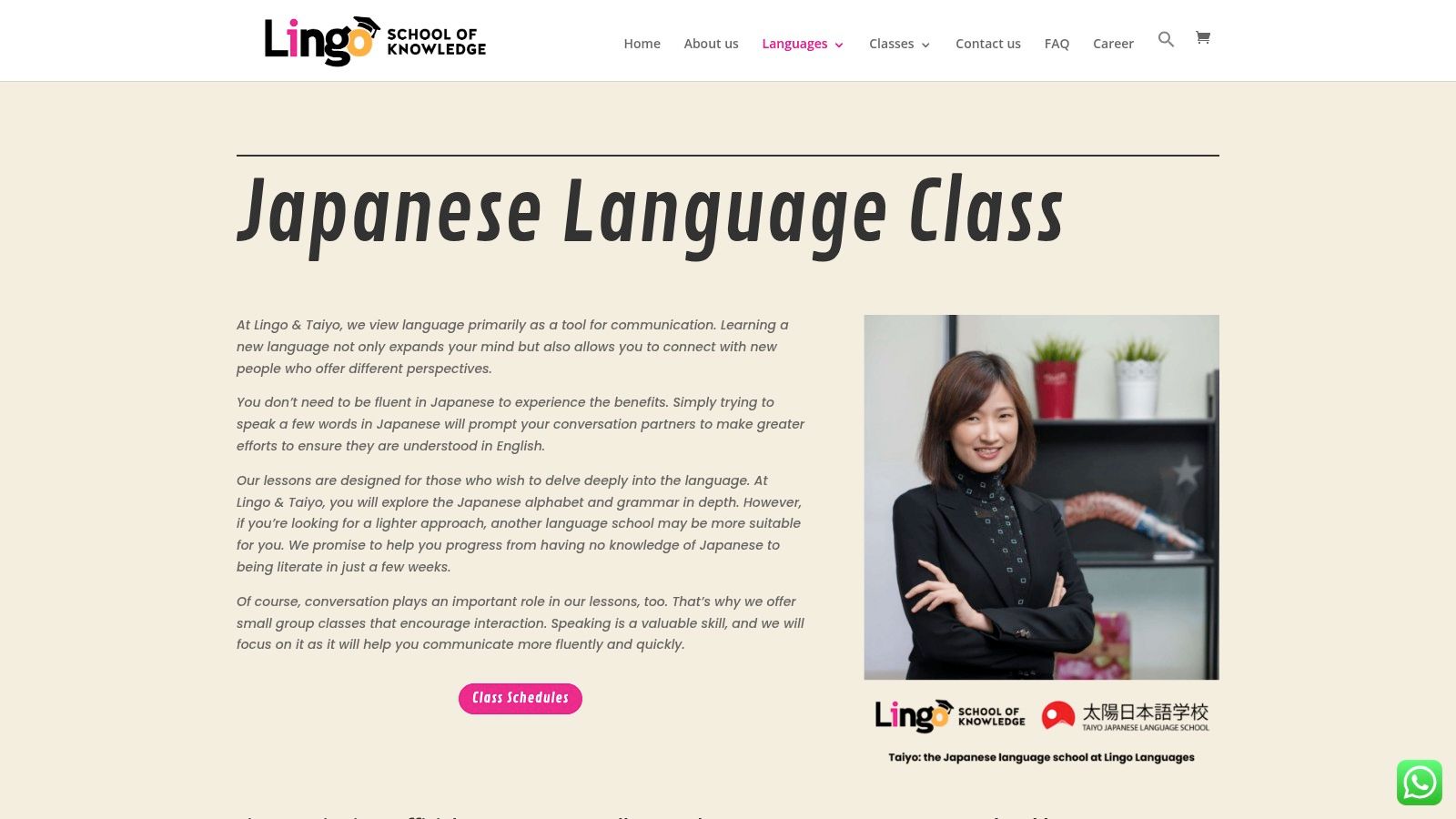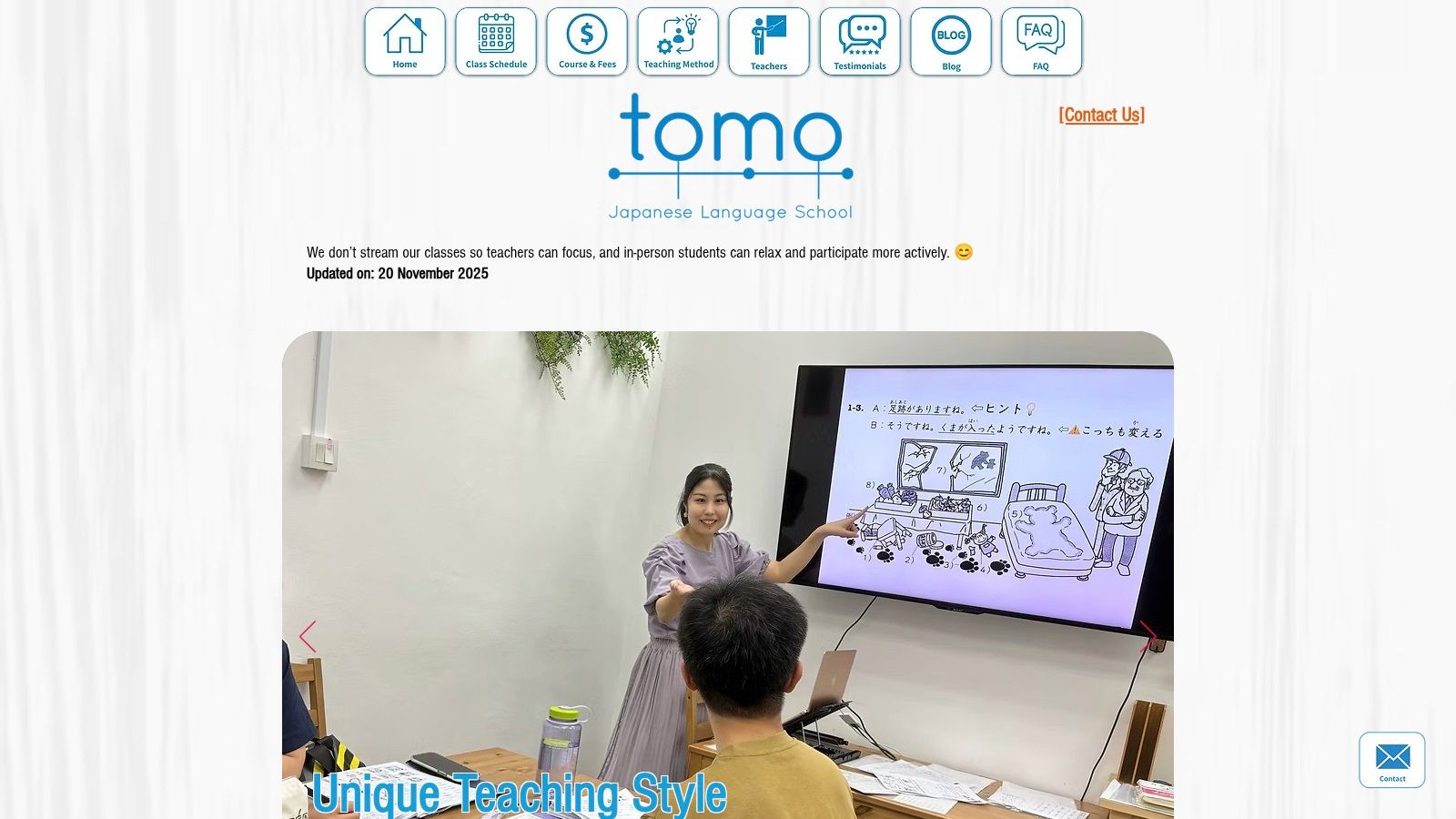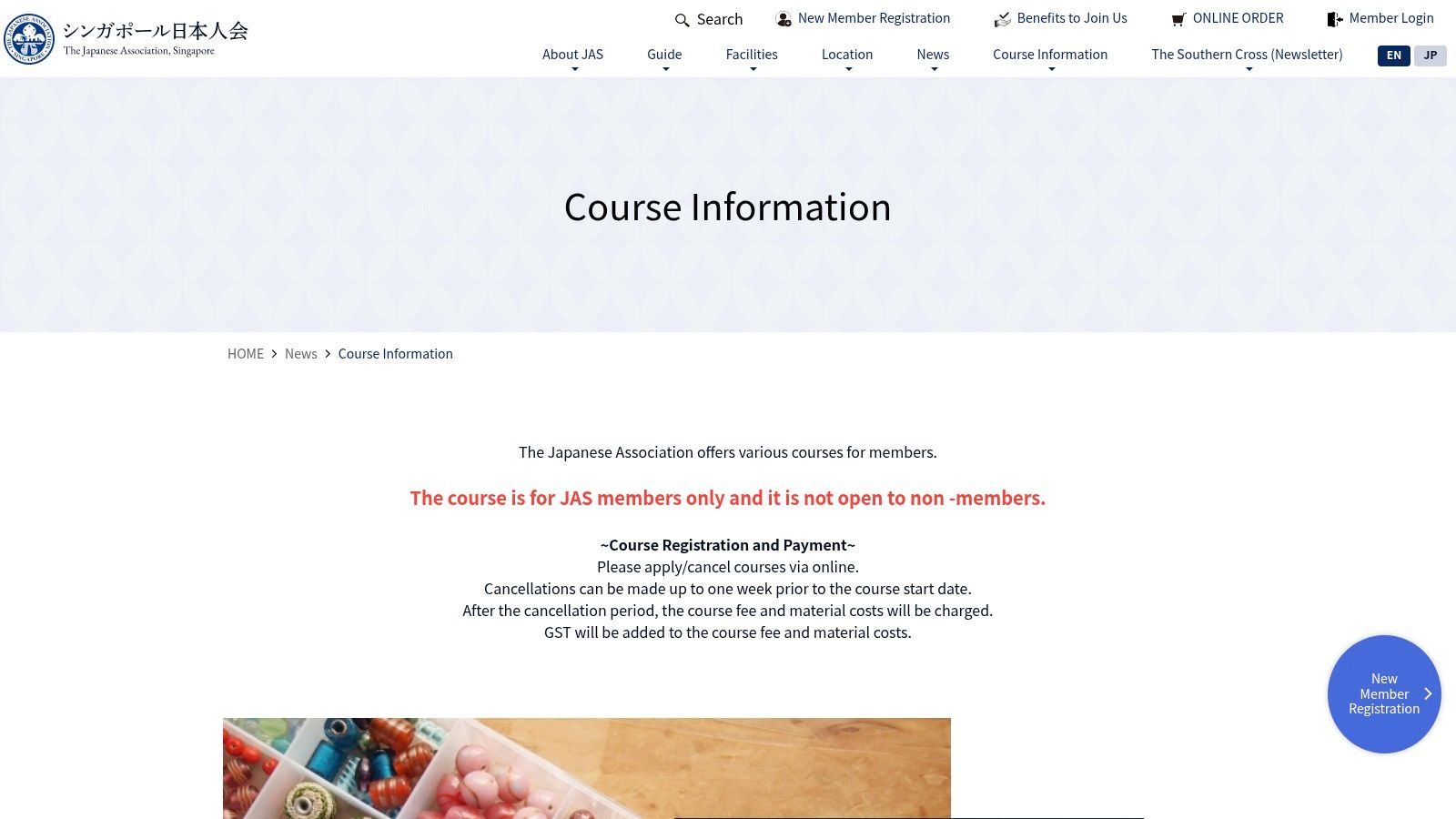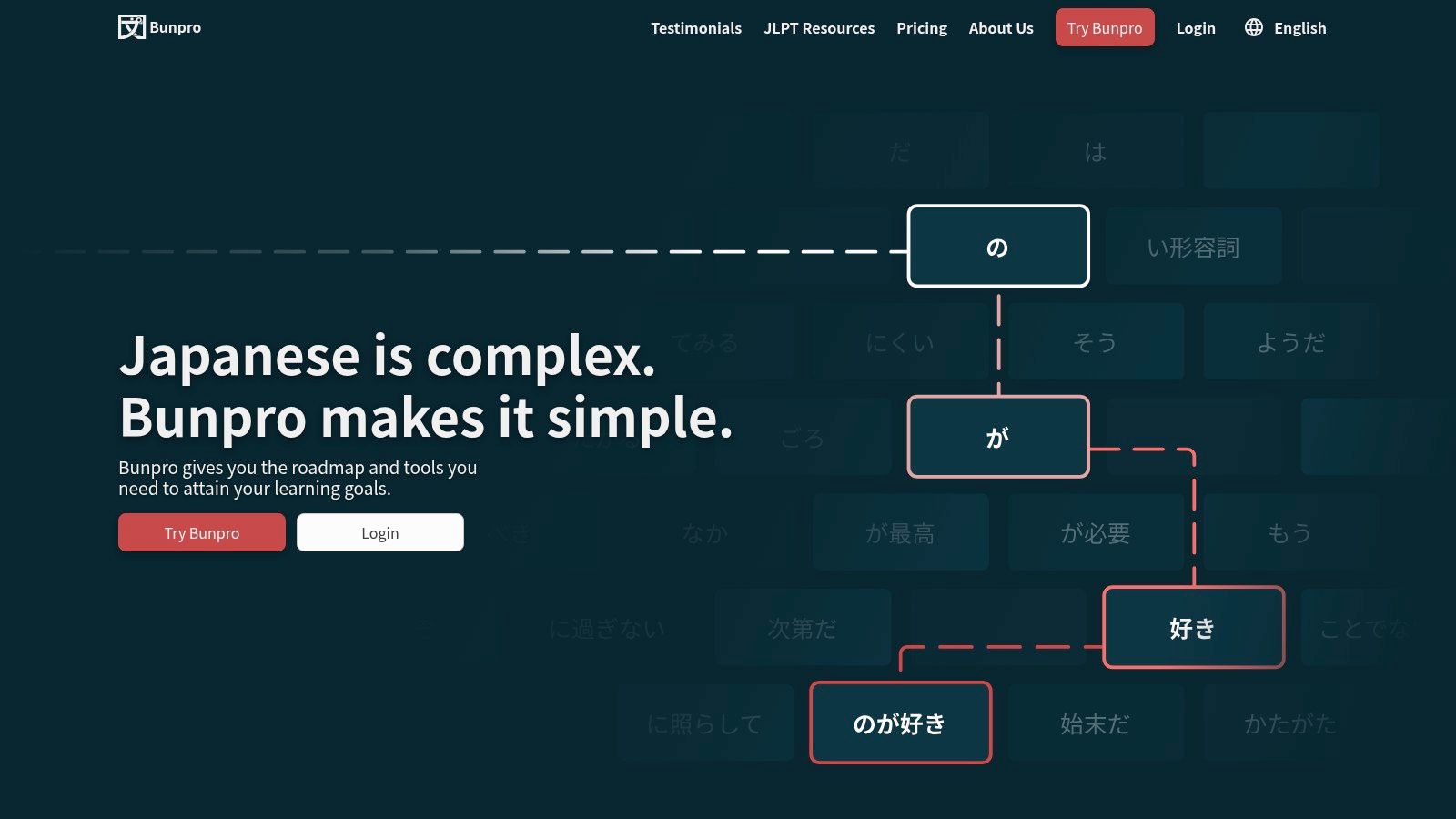learning japanese in singapore: 2025 guide & top resources
Thinking about learning Japanese in Singapore? You're not alone. Whether you're aiming for the JLPT, planning a trip to Tokyo, or just love anime, finding the right resources is the first crucial step. The city offers a vibrant mix of traditional language schools, modern digital platforms, and cultural hubs to support your goals. But with so many choices, it's easy to feel overwhelmed and difficult to know where to begin.
This guide cuts through the noise. We have compiled a comprehensive list of the 12 best resources available right here in Singapore. From established schools in Orchard like Bunka to powerful self-study apps like WaniKani, this article is designed to help you build a personalised and effective learning plan.
We will explore the unique strengths, practical limitations, and ideal use cases for each option. This ensures you can confidently choose the path that best fits your budget, schedule, and learning style. Each entry includes direct links to get you started immediately. Our goal is to provide a clear, actionable roadmap so you can stop researching and start your Nihongo journey today.
1. Japanese Cultural Society, Singapore (JCS)
As the official organiser of the Japanese Language Proficiency Test (JLPT) in Singapore, the Japanese Cultural Society (JCS) is a cornerstone for anyone serious about learning Japanese in Singapore. This non-profit organisation offers a structured, multi-level curriculum that aligns closely with JLPT standards, from absolute beginner (Basic 1) to further-advanced courses. Its website is the primary hub for course registration, term schedules, and most importantly, all official JLPT registration logistics and test centre information for local sittings.
What sets JCS apart is its integration of cultural immersion with formal education. Beyond the classroom, members can participate in activities like tea ceremonies, yukata wearing, and regular conversation corners. This provides an invaluable community environment to practise Japanese organically. The experience feels less like a school and more like a cultural centre, offering a holistic approach to language acquisition.
Key Considerations
| Feature | Details |
|---|---|
| Best For | Learners seeking a structured pathway to JLPT certification and a local community hub. |
| Course Structure | Fixed term-based schedules with placement tests for non-beginners. |
| Pros | A single, trusted source for both structured courses and official JLPT logistics in Singapore. Strong community and cultural exposure. |
| Cons | Popular course intakes can fill up very quickly. The fixed schedule offers less flexibility than online platforms. |
The JCS conversation corners, in particular, serve as excellent forums for casual practice, similar to other language exchange events in Singapore.
Website: https://www.jcss.org.sg
2. IKOMA Language School
With a history stretching back to 1996, IKOMA Language School is a well-established institution for anyone looking into learning Japanese in Singapore. Located conveniently in Shaw House at Orchard, it offers a predictable and structured curriculum designed to guide students from basic proficiency to advanced levels. The website is the central place to find course schedules, fee structures, and register for both part-time evening classes and weekday intensive programmes, catering to different learning paces.
IKOMA’s strength lies in its time-tested pedagogical approach. Beginner courses utilise the widely-recognised Minna no Nihongo textbook series, ensuring a solid foundation in grammar and vocabulary. The school’s level progression is clearly mapped towards JLPT milestones, making it an excellent choice for learners who thrive on clear goals and a formal classroom environment. This direct alignment provides a straightforward path for those aiming for certification.
Key Considerations
| Feature | Details |
|---|---|
| Best For | Learners who prefer a traditional classroom setting with a clear, textbook-based curriculum. |
| Course Structure | Term-based with options for part-time (evening/weekend) or intensive weekday classes. |
| Pros | Long-standing reputation and a structured path towards JLPT competency. Flexible scheduling options suit both students and working professionals. |
| Cons | Course availability and specific timings are dependent on each term's intake, requiring you to check the website for the latest schedule. |
IKOMA's focused, academic approach makes it a strong contender among any top language school in Singapore.
Website: https://www.ikoma.com.sg
3. Bunka Language School
As one of Singapore's most established Japanese-specialist language schools, Bunka Language School has been a fixture for learning Japanese in Singapore since 1987. Centrally located in Orchard, it offers a focused environment dedicated solely to the Japanese language. Its curriculum covers a complete pathway from elementary to advanced levels, with specific courses geared towards JLPT preparation and conversational fluency. The school's website provides course outlines, schedules, and contact details for enrolment.
What truly distinguishes Bunka is its long-standing reputation and commitment to small class sizes, typically capped at around 12 students. This intimate setting ensures learners receive more personalised attention and opportunities for interaction compared to larger institutions. The school's singular focus on Japanese means its instructors and resources are highly specialised, providing an immersive and effective learning experience for students at all levels. This makes it a popular choice for those who value direct teacher engagement.
Key Considerations
| Feature | Details |
|---|---|
| Best For | Learners who prefer small, focused classes and a dedicated, long-running specialist school. |
| Course Structure | Multi-level courses with JLPT and conversation tracks, offered with frequent term intakes. |
| Pros | Decades of specialised experience in teaching Japanese. Small classes foster a conducive learning environment with more individual guidance. |
| Cons | The official website is quite lean on details; prospective students often need to enquire directly for the latest fees and schedules. |
Website: http://www.bunkalang.com
4. PYAESS Japanese Language School
As a Ministry of Education (MOE) registered centre with roots dating back to 1988, PYAESS Japanese Language School offers a time-tested approach to learning Japanese in Singapore. The school provides a wide array of courses, from standard group classes and intensive programmes to specialised JLPT preparation and corporate training. Its website serves as a primary point of contact for understanding its course philosophy, which strongly emphasises conversational practice and practical application from day one.
What distinguishes PYAESS is its long-standing reputation and clear pedagogical approach, especially for beginners. Instructors are bilingual in Japanese and English, which helps to bridge the initial learning gap by explaining complex grammar points in a familiar language. This focus on clear, accessible instruction ensures students build a solid foundation before advancing to more immersive, Japanese-only environments, making the initial stages of learning less intimidating.
Key Considerations
| Feature | Details |
|---|---|
| Best For | Beginners seeking a traditional classroom setting with bilingual support and a focus on speaking. |
| Course Structure | Diverse options including group, private, intensive, and corporate classes. |
| Pros | Decades of operation provide an established reputation. The bilingual teaching method is highly effective for absolute beginners. |
| Cons | The website is quite basic; detailed schedules and fee structures often require a direct phone call or email enquiry. |
The direct, hands-on teaching style at PYAESS is ideal for learners who thrive on classroom interaction and immediate feedback from instructors.
Website: https://pyaess.edu.sg
5. Lingo Language School (Japanese)
Lingo Language School offers a modern, accessible approach for those learning Japanese in Singapore, with a convenient city-centre location and flexible learning formats. Its website is designed for clarity, featuring transparent timetables with published start dates and course fees for its group classes. This straightforward presentation allows prospective students to easily find a suitable intake and understand the costs upfront, removing common barriers to enrolment.
What sets Lingo apart is its emphasis on small, intimate learning environments. With group classes capped at around eight students, learners receive more personalised attention from instructors. The school also provides both onsite and live online (Zoom) options, catering to different schedules and preferences. For those seeking an even more tailored curriculum, one-to-one private lessons are available, making it a strong choice for professionals or students with specific goals.
Key Considerations
| Feature | Details |
|---|---|
| Best For | Learners who prefer small group sizes, transparent scheduling, and the flexibility of hybrid (onsite/online) learning. |
| Course Structure | Group classes with fixed schedules and private one-to-one lessons with customisable pacing. |
| Pros | Clear, up-to-date schedule with published fees. Small class sizes ensure more individual attention. Flexible private lesson options. |
| Cons | In-house certificates of completion are not formal academic qualifications. Private lessons may have minimum package requirements. |
Lingo's preview classes are a valuable feature, allowing potential students to experience the teaching style before committing to a full term.
Website: https://www.lingo.edu.sg/japanese/
6. Tomo Japanese Language School
Tomo Japanese Language School is a boutique institution that carves a niche for itself by focusing squarely on conversational proficiency. For learners who find traditional, grammar-heavy methods daunting, Tomo offers a refreshing, speaking-first approach to learning Japanese in Singapore. The curriculum, led entirely by native Japanese teachers, heavily incorporates the 'shadowing' technique, where students repeat after the instructor to master natural intonation and rhythm from day one.
The school’s website transparently lays out its 10-lesson term schedules and course fees, even allowing for pro-rated joining mid-term if a class has vacancies. This structure provides a clear commitment without the long-term lock-in of larger institutions. The emphasis is less on rigid exam preparation and more on building the practical confidence needed for real-world communication, making it an excellent choice for those who want to speak the language fluently.
Key Considerations
| Feature | Details |
|---|---|
| Best For | Learners prioritising conversational fluency and practical speaking skills over academic study. |
| Course Structure | 10-lesson terms with rolling timetables and options to join mid-course. |
| Pros | Strong orientation toward speaking and communicative practice. Native-led classes improve pronunciation and natural usage. |
| Cons | As a smaller school, it offers fewer concurrent class options. Textbooks and materials are an additional cost. |
Website: https://www.tomo-japanese.com
7. Japanese Association, Singapore (JAS) – Language Centre
The Japanese Association, Singapore (JAS) serves as a key community hub for Japanese expatriates and locals, offering a rich blend of cultural and educational programmes. Its language centre is an excellent resource for anyone learning Japanese in Singapore, providing term-based courses that run quarterly throughout the year. The website is the go-to portal for viewing upcoming schedules, understanding the fee structures, and registering for both language classes and other cultural activities.
What makes JAS distinct is its integrated community environment. Learning here means more than just attending classes; it's about being part of a broader cultural ecosystem. The association frequently organises events and arts programmes, allowing language learners to immerse themselves directly in Japanese culture. Pricing is transparent, with clear distinctions between member and non-member fees, making it easy to assess the value and commitment required for each term.
Key Considerations
| Feature | Details |
|---|---|
| Best For | Learners who value a community setting that combines language with cultural and artistic immersion. |
| Course Structure | Fixed quarterly terms (e.g., Jan–Mar, Apr–Jun) with a broad mix of language and cultural classes. |
| Pros | A holistic learning environment within an established cultural association. Transparent fee bands are published online. |
| Cons | Course availability and scheduling can be limited and vary each term. Some offerings may prioritise JAS members. |
Website: https://www.jas.org.sg/en/course
8. Kinokuniya Singapore (Books)
A quality textbook is a non-negotiable tool for anyone committed to learning Japanese in Singapore, and Kinokuniya is the go-to local supplier. This major Japanese bookstore chain has several physical branches and a comprehensive online store, making it the most reliable place to source essential learning materials without waiting for international shipping. Their shelves are stocked with core textbook series like Genki and Minna no Nihongo, alongside crucial JLPT preparation books from the So-Matome and Kanzen Master series.
What makes Kinokuniya indispensable is its curated selection and expertise. You can physically browse the materials, which is a significant advantage over buying online sight-unseen. Their website also allows you to check stock availability at different branches, ensuring you don't make a wasted trip. When sourcing your Japanese learning books, understanding how to approach structured materials is key. You might benefit from consulting general resources like a reader's guide to books in order to plan your study path effectively.
Key Considerations
| Feature | Details |
|---|---|
| Best For | Learners of all levels who need to purchase physical textbooks, workbooks, and JLPT prep materials locally. |
| Course Structure | N/A (Retailer of self-study materials). |
| Pros | Immediate local availability of core Japanese learning books. Ability to browse materials before purchasing. Trusted retailer with expertise in Japanese publications. |
| Cons | Popular titles can go out of stock, especially near JLPT dates. Prices can be higher than overseas online retailers due to import costs. |
Website: https://kinokuniya.com.sg
9. WaniKani
While many local schools focus on grammar and conversation, mastering kanji often requires a dedicated tool, and WaniKani is a global favourite for this very purpose. This online platform specialises in teaching kanji and vocabulary through a structured system of radicals, mnemonics, and spaced repetition (SRS). It gamifies the process of learning complex characters, making it a highly effective supplement for anyone learning Japanese in Singapore, regardless of their primary study method. It breaks down kanji into simpler radical components, attaching memorable stories to aid long-term recall.
What sets WaniKani apart is its laser focus on an efficient, repeatable learning path. The platform dictates what you study and when, ensuring you review characters just before you forget them. While the first few levels are free, a subscription (monthly, annual, or lifetime) is needed to unlock its full potential. The web and mobile apps sync seamlessly, allowing learners in Singapore to fit in review sessions during their daily commute or lunch breaks, turning downtime into productive study time.
Key Considerations
| Feature | Details |
|---|---|
| Best For | Self-motivated learners who need a powerful, structured system to memorise kanji and vocabulary. |
| Course Structure | SRS-driven online platform with a fixed progression path through 60 levels. |
| Pros | Extremely effective mnemonic-based system for kanji retention. Integrates well as a supplementary tool alongside grammar studies. |
| Cons | Solely focuses on reading (kanji and vocab) and does not teach grammar, speaking, or listening. A paid subscription is required for full access. |
Website: https://www.wanikani.com
10. Bunpro
While many apps focus on vocabulary, Bunpro zeroes in on the often-tricky world of Japanese grammar. This web and app-based platform uses a Spaced Repetition System (SRS) specifically designed to help you master over 900 grammar points, all neatly organised by JLPT level. For learners who find themselves knowing many words but struggling to form correct sentences, Bunpro provides the structured, drill-based practice needed to make grammar rules stick. This makes it an essential tool for learning Japanese in Singapore, complementing formal lessons with targeted self-study.
What makes Bunpro stand out is its depth. Each grammar point comes with multiple example sentences, native audio recordings, and direct links to popular textbook explanations (like Genki and Minna no Nihongo). This creates a powerful, interconnected study ecosystem. You can track your progress for each JLPT level, identify weak points, and relentlessly practise them until they become second nature. It’s the perfect digital grammar workbook for the modern learner.
Key Considerations
| Feature | Details |
|---|---|
| Best For | Learners who need structured, SRS-based practice to master grammar for exams like the JLPT. |
| Course Structure | Self-paced grammar drills organised by JLPT levels (N5 to N1) and textbook paths. |
| Pros | Deep grammar explanations and drill-focused practice. JLPT-aligned structure and study dashboards for targeted prep. |
| Cons | Input-based reviews can feel demanding for casual users. Some learners may prefer more guided lesson content alongside SRS. |
Website: https://bunpro.jp
11. LingoDeer
For learners who prefer a structured, app-based approach, LingoDeer offers one of the most comprehensive mobile-first curricula for learning Japanese in Singapore. It moves beyond simple vocabulary drills to provide a well-organised course that covers hiragana, katakana, grammar, and sentence patterns from the ground up. Its methodology is ideal for building a solid foundation in your own time, acting as a powerful supplement to formal classes or as a primary self-study tool.
What sets LingoDeer apart is its detailed grammar explanations and integrated Spaced Repetition System (SRS) for reviews. The platform feels like a textbook transformed into an interactive app, complete with clear audio from native speakers. With availability on both web and mobile, learners can seamlessly switch between devices, and its periodic promotional pricing for lifetime access often presents a cost-effective alternative to recurring subscriptions.
Key Considerations
| Feature | Details |
|---|---|
| Best For | Self-starters looking for a structured, grammar-focused app to build a strong foundation. |
| Course Structure | App-based curriculum with tiered lessons, built-in SRS reviews, and phrasebooks. |
| Pros | Excellent, clear grammar explanations and a logical learning path. Cost-effective with promotional lifetime plans. |
| Cons | Limited feedback on speech and pronunciation. Promotional pricing can vary significantly depending on the time and platform. |
Website: https://www.lingodeer.com
12. Duolingo (Japanese)
As a household name in language learning, Duolingo offers an accessible and gamified entry point for anyone considering learning Japanese in Singapore. The platform is renowned for its bite-sized lessons and habit-forming mechanics, like daily streaks and leaderboards, making it easy to incorporate a few minutes of practice into a busy schedule. Its free-to-use core model removes any financial barrier to getting started with hiragana, katakana, and basic vocabulary.
What makes Duolingo a valuable tool is its role as a supplementary resource. While it may not replace a structured course for deep grammatical understanding or JLPT preparation, it excels at reinforcing vocabulary and sentence patterns on the go. Its constant content updates and cross-platform availability ensure you can practise anytime, whether on your daily commute or during a short break, keeping the language top of mind.
Key Considerations
| Feature | Details |
|---|---|
| Best For | Absolute beginners building a daily practice habit and learners needing a fun, supplementary tool. |
| Course Structure | Gamified, sequential learning path with optional paid tiers (Super/Max) to remove ads and add features. |
| Pros | Zero-cost entry makes it easy to start and maintain daily habits. Light, gamified practice that complements other study resources. |
| Cons | Not a full replacement for structured classroom instruction or intensive JLPT prep. Japanese-specific features roll out gradually. |
Duolingo’s on-the-go format makes it a great example of the flexibility offered by an online class in Singapore.
Website: https://www.duolingo.com
Learning Japanese in Singapore — 12-Resource Comparison
| Provider | Core Features | Quality ★ | Price / Value 💰 | Target 👥 | Unique Selling Points ✨ |
|---|---|---|---|---|---|
| Japanese Cultural Society, Singapore (JCS) | JLPT-aligned course ladder; JLPT registration & test logistics; cultural events | ★★★★ 🏆 | 💰 Mid-term; community rates | 👥 JLPT candidates & community learners | ✨ Official JLPT logistics + cultural immersion |
| IKOMA Language School | Part-time & weekday intensives; Minna no Nihongo; JLPT-mapped levels; Orchard location | ★★★★ | 💰 Mid-range (varies by term) | 👥 Working adults & serious learners | ✨ Predictable curriculum + flexible schedules |
| Bunka Language School | Small classes (~12); multi-level JLPT focus; long-running (since 1987) | ★★★★ | 💰 Mid (enquire for current fees) | 👥 Learners wanting JP-only immersion | ✨ Decades of JP-only teaching; small groups |
| PYAESS Japanese Language School | MOE-registered; bilingual JP/EN instructors; broad course menu incl. corporate & kids | ★★★★ | 💰 Mid; corporate pricing available | 👥 Beginners needing bilingual support; corporates | ✨ MOE registration + bilingual approach |
| Lingo Language School (Japanese) | Small-group (~8) & 1:1; onsite + Zoom; preview classes; certificates | ★★★★ | 💰 Transparent published fees; package mins | 👥 Adults seeking personalised lessons | ✨ Clear schedules & preview classes |
| Tomo Japanese Language School | Conversation-first; shadowing technique; 10-lesson rolling terms; native teachers | ★★★★ | 💰 Transparent per-term pricing; materials extra | 👥 Conversation-focused learners | ✨ Shadowing method for speaking fluency |
| Japanese Association, Singapore (JAS) – Language Centre | Term-based courses (4 terms/yr); cultural & arts programmes; member/non-member pricing | ★★★ | 💰 Published fee bands; member discounts | 👥 Members, community & cultural learners | ✨ Community hub combining language + arts |
| Kinokuniya Singapore (Books) | Local bookstore & online catalogue; JLPT textbooks & resources; store pickup | ★★★★ | 💰 Retail pricing; import variance | 👥 Self-study students & teachers | ✨ Reliable local source for core textbooks |
| WaniKani | SRS-driven kanji & vocab; radicals + mnemonic system; web & mobile; free early levels | ★★★★ 🏆 | 💰 Freemium; monthly/annual/lifetime plans | 👥 Self-learners focused on kanji | ✨ Radicals + mnemonic SRS for fast recall |
| Bunpro | Grammar SRS with 900+ points; JLPT dashboards; native audio & textbook refs | ★★★★ | 💰 Freemium; paid plans & lifetime option | 👥 JLPT grammar-focused learners | ✨ Deep grammar drills + JLPT tracking |
| LingoDeer | Structured kana/grammar courses; built-in SRS; web & mobile; phrasebooks | ★★★★ | 💰 App subscription; frequent promotions | 👥 Self-study beginners/intermediates | ✨ Structured lessons tuned to Asian languages |
| Duolingo (Japanese) | Gamified bite-sized lessons; free core content; Super/Max tiers; frequent updates | ★★★ | 💰 Free entry; optional paid tiers | 👥 Casual learners & habit builders | ✨ Low barrier + gamified daily practice |
Building Your Personalised Japanese Learning Toolkit
Embarking on the journey of learning Japanese in Singapore can feel like navigating a bustling city-state, with countless paths and destinations. As we have explored, from the structured curricula of established institutions like the Japanese Cultural Society and IKOMA Language School to the focused digital drills of WaniKani and Bunpro, there is no single "best" way to achieve fluency. The most effective approach is not to search for one perfect resource, but to build a customised, multifaceted toolkit tailored to your unique learning style, goals, and schedule.
Crafting Your Learning Ecosystem
Think of your learning journey as a well-balanced diet. A physical language school provides the essential, foundational nutrients: structured grammar, expert guidance, and the accountability of a classroom setting. This is your core, ensuring you build a solid understanding of the language from the ground up.
Complement this with daily "snacks" of digital learning. Use your commute on the MRT to master kanji with WaniKani or reinforce grammar points with Bunpro. These tools are designed for short, frequent sessions, making them perfect for integrating study into a busy Singaporean lifestyle. Apps like Duolingo or LingoDeer can serve as light, enjoyable exercises to maintain momentum and keep the language top-of-mind, even on days when you feel less motivated.
The Power of Immersion and Integration
True mastery, however, happens when you step outside the textbook and into the living language. This is where Singapore's unique position as a cultural hub comes into play. Make regular visits to Kinokuniya a part of your routine to browse manga and Japanese literature. Participate in cultural events organised by the Japanese Association, Singapore to practise your listening and speaking skills in a natural, low-pressure environment.
To make your toolkit even more dynamic, consider how different media can enhance your studies. Many online platforms and even some language schools are now incorporating video content. To truly build a personalized learning toolkit, consider how to best incorporate multimedia, exploring resources that focus on utilizing videos effectively for student learning to boost comprehension and retention. The goal is to create an ecosystem where you are consistently interacting with Japanese in various forms.
Ultimately, your success in learning Japanese in Singapore hinges on two key factors: consistency and combination. Choose one or two primary resources to start, perhaps a formal course and a supplementary app. Stick with them consistently, and as you progress, strategically add more tools to address your weaknesses and fuel your interests. Stay patient, celebrate small victories, and embrace the process. Your personalised learning toolkit will be the key that unlocks not just a new language, but a new world of culture and connection.
Inspired to apply these learning principles to another global language? The philosophy of blending structured education with cultural immersion is universal. If you are considering expanding your linguistic skills, explore the vibrant courses offered by Spanish Council Singapore to begin your journey with Spanish right here in Singapore.


